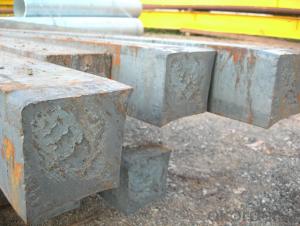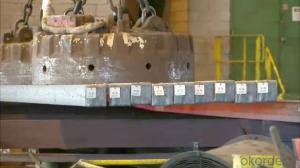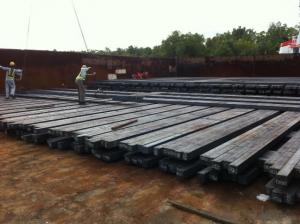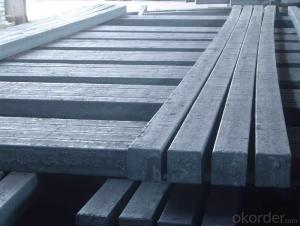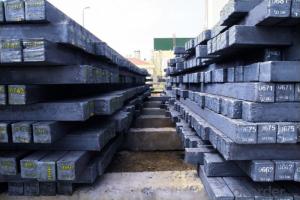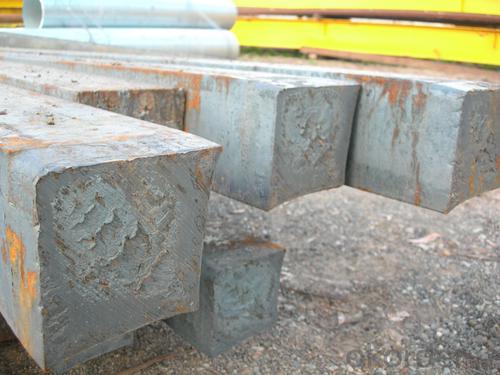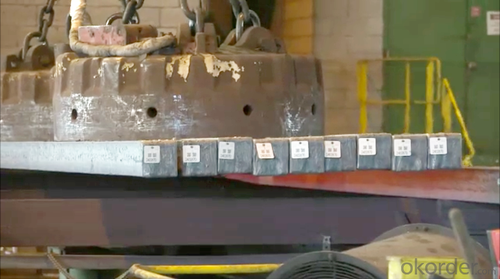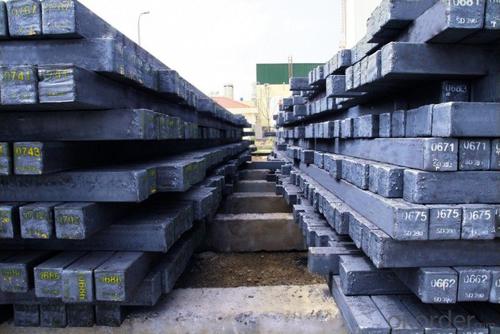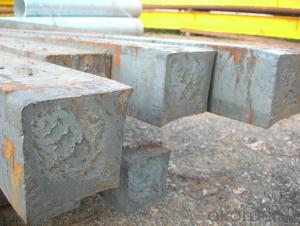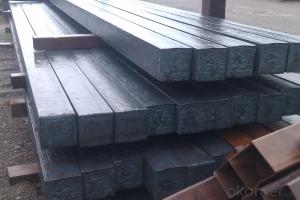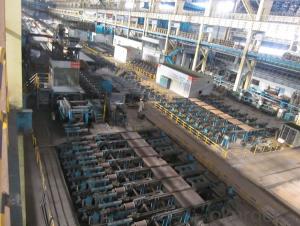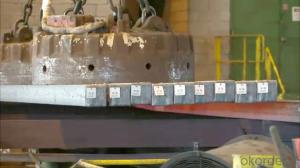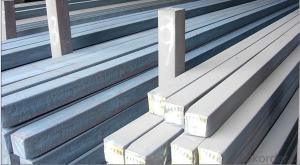Prime quality square alloy steel billet 140mm Q235
- Loading Port:
- Tianjin
- Payment Terms:
- TT OR LC
- Min Order Qty:
- 100 m.t.
- Supply Capability:
- 10000 m.t./month
OKorder Service Pledge
OKorder Financial Service
You Might Also Like
Structure of Prime quality square alloy steel billet 140mm Q235
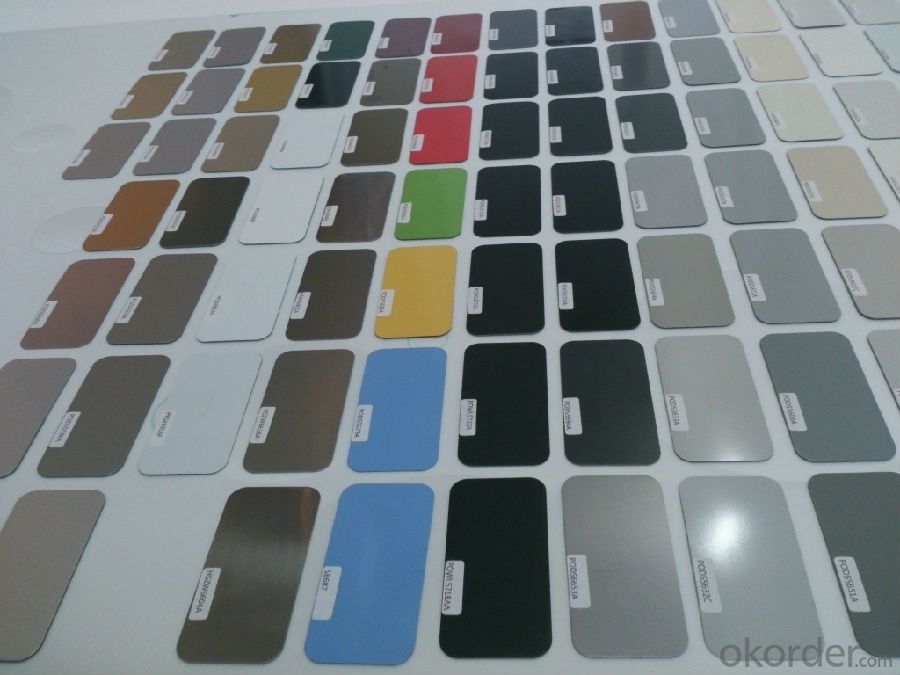
Description of Prime quality square alloy steel billet 140mm Q235
1. Prepainted steel coil is coated with organic layer, which provides higher anti-corrosion property and a longer lifespan than that of galvanized or galvalume steel sheets.
2. The base metals for prepainted steel coil consist of cold rolled, HDGI Steel, electro-galvanized and hot-dip alu-zinc coated steel. The finish coats of prepainted steel coil can be classified into groups as follows: polyester, silicon modified polyesters, polyvinylidene fluoride, high-durability polyester, etc.
3. The production process has evolved from one-coating-and-one-baking to double-coating-and-double-baking, and even three-coating-and-three-baking.
4. The color of the prepainted steel coil has a very wide selection, like orange, cream-colored, dark sky blue, sea blue, bright red, brick red, ivory white, porcelain blue, etc.
5. The prepainted steel coils can also be classified into groups by their surface textures, namely regular prepainted sheets, embossed sheets and printed sheets.

Main Feature of Prime quality square alloy steel billet 140mm Q235
Uncoated CR steel sheet
With the features of in line with the international highest standards in demension and shape, excellent surface finish and properties, the products are mainly used in home appliance and automobile industries.
Galvanized steel sheet(include HDG and EG)
With the features of good corrosion resistance, the products are mainly used in automobile, home appliance, electronics, building and machinery manufacture industries, etc.
Precoated steel sheet
With the features of enviromental protection and good processablility, long lasting surface durability, rich in colors, the products are maily used in building, home appliance and furniture industries, etc.
Applications of Prime quality square alloy steel billet 140mm Q235
Construction
Manufacture anticorrosion, industrial and civil architecture roof boarding, roof grille
Light industries
Home appliance's case, civil chimney, kitchen utensils
Auto industry
Corrosion resistant parts of cars
Agriculture
Food storage, meat and aquatic products' freezing and processing equipment
Commerce
Equipments to store and transport materials, and packing implements

Specifications of Prime quality square alloy steel billet 140mm Q235
Product | Prime quality square alloy steel billet 140mm Q235 |
Material Grade | SGCC / SGCH / DX51D+AZ, etc |
Thickness | 0.6-3.0mm |
Width | 500-1500mm |
Tolerance | Thickness: +/-0.02mm , Width:+/-2mm |
Zinc-coating | Z30-150g/m2 |
Technique | Raw material: Hot rolled steel coil --> Cold rolled_>hot dipped galvalume |
Surface | Dried, Chromated, Unoiled |
Spangle | Regular spangle , small spangle, zero spangle |
ID | 508MM 610MM |
Coil weight | 1-25MT |
Export package | Cardboard inner sleeves, Waterproof paper, galvanized steel covered and steel strip packed |
FAQ of Prime quality square alloy steel billet 140mm Q235
We have organized several common questions for our clients,may help you sincerely:
1. How Can I Visit There?
Our company is located in Tianjin City, China, near Beijing. You can fly to Tianjin Airport Directly. All our clients, from home or aboard, are warmly welcome to visit us!
2. How Can I Get Some Sample?
We are honored to offer you sample.
3. Why choose CNBM?
Our delivery time about 15-20days for standard sizes, if you have other requirements like hardness, quanity and width ,it is about 20-40days. But don't worry we also try our best for the delivery time ,because time longer and our cost is higher.
- Q: Can steel billets be used in marine environments?
- Certainly! Steel billets have the potential to be utilized in marine settings. Due to its robustness, durability, and ability to resist corrosion, steel is a favored material for a variety of marine purposes. Semi-finished steel billets can be transformed into numerous marine components, such as ship hulls, offshore platforms, and marine structures. To endure the challenging conditions of marine environments, which involve exposure to saltwater, steel utilized in these applications is typically treated with anti-corrosion coatings or alloys. These protective measures serve to prevent the corrosion of steel and preserve its structural integrity, enabling it to withstand the corrosive effects of seawater and other marine elements. Additionally, steel billets can undergo further processes, including hot rolling, forging, or extrusion, to shape them into the desired marine components. These processes additionally enhance the mechanical properties of the steel, making it suitable for marine applications where high strength and resistance to impact and fatigue are imperative. Overall, steel billets can be effectively utilized in marine environments, on the condition that they are appropriately treated and processed to withstand the corrosive nature of seawater and fulfill the specific requirements of marine applications.
- Q: What are the different methods of steel billet surface painting?
- There are several different methods of steel billet surface painting that are commonly used in various industries. These methods include: 1. Spray painting: This is one of the most common methods, where a spray gun is used to apply a thin and even layer of paint onto the steel billet surface. It provides a smooth and consistent finish and allows for quick and efficient coverage. 2. Powder coating: In this method, a dry powder is applied to the steel billet surface using an electrostatic charge. The powder adheres to the surface and is then heated to form a durable and long-lasting coating. Powder coating offers excellent resistance to corrosion, chemicals, and abrasion. 3. Electroplating: This method involves immersing the steel billet into a solution containing a metal salt. A direct current is then applied, causing the metal ions in the solution to be deposited onto the surface of the billet. Electroplating provides a protective and decorative coating, enhancing the appearance and durability of the steel. 4. Hot-dip galvanizing: This method involves immersing the steel billet into a bath of molten zinc. The zinc forms a protective layer on the surface of the billet, providing excellent corrosion resistance. Hot-dip galvanizing is commonly used for outdoor applications where the steel is exposed to harsh environmental conditions. 5. Epoxy coating: Epoxy coatings are applied as a two-part system, where a resin and a hardener are mixed together and then applied to the steel billet surface. The epoxy cures to form a tough and chemical-resistant coating that provides protection against corrosion and abrasion. 6. Electrophoretic painting: This method involves immersing the steel billet into a tank containing a paint solution and applying an electric current. The paint particles in the solution migrate towards the billet surface due to the electric charge, resulting in a uniform and consistent coating. Each of these methods has its own advantages and disadvantages, and the choice of method depends on factors such as the desired finish, the environment in which the steel billet will be used, and the required level of protection.
- Q: What are the main factors affecting the quality of steel billets?
- There are several main factors that can significantly affect the quality of steel billets. These factors include the composition of the steel, the temperature and time of the heating process, the cooling rate, and the presence of impurities. Firstly, the composition of the steel plays a crucial role in determining its quality. The presence of certain elements such as carbon, manganese, and silicon can affect the mechanical properties of the steel, including its strength and hardness. The proper control and balance of these alloying elements are essential to ensure the desired quality of the steel billets. Secondly, the temperature and time of the heating process during the production of steel billets are critical factors. The heating process must be carefully controlled to achieve the optimal temperature for the desired transformation of the microstructure. Overheating or underheating can lead to the formation of undesirable phases or an inconsistent microstructure, which can negatively impact the quality of the billets. The cooling rate is another important factor affecting the quality of steel billets. The cooling process needs to be controlled to achieve the desired microstructure and mechanical properties. Too rapid cooling can result in the formation of brittle phases or residual stresses, while slow cooling can lead to coarse-grained structures with reduced strength. Furthermore, the presence of impurities in the steel can significantly affect its quality. Impurities such as sulfur, phosphorus, and non-metallic inclusions can decrease the mechanical properties and promote the formation of defects in the steel billets. Therefore, strict control of the raw materials and the implementation of effective refining techniques are necessary to minimize the presence of impurities. In conclusion, the main factors affecting the quality of steel billets are the composition of the steel, the temperature and time of the heating process, the cooling rate, and the presence of impurities. By carefully controlling and optimizing these factors, steel manufacturers can produce high-quality billets that meet the desired specifications and performance requirements.
- Q: What are the main factors affecting the dimensional tolerances of steel billets?
- The main factors affecting the dimensional tolerances of steel billets include the quality of the raw material used, the manufacturing process employed, and the precision of the equipment and tools used during production. Additionally, environmental conditions such as temperature and humidity can also impact the dimensional tolerances of steel billets.
- Q: How are steel billets used in the production of transmission towers?
- Steel billets are used in the production of transmission towers as the raw material for manufacturing tower sections. These billets are cut, shaped, and welded to create the structural components of the towers, ensuring strength, stability, and durability in supporting electrical transmission lines.
- Q: What are the environmental impacts of manufacturing steel billets?
- The manufacturing of steel billets has several environmental impacts. The process involves significant energy consumption, which often relies on non-renewable sources, leading to high greenhouse gas emissions. Additionally, the extraction and processing of raw materials, such as iron ore and coal, can cause habitat destruction, deforestation, and water pollution. Furthermore, the production of steel billets generates waste and byproducts, including slag and dust, which can have detrimental effects on air and water quality if not properly managed. Overall, the manufacturing of steel billets has notable environmental implications that need to be addressed through sustainable practices and technological advancements.
- Q: Can steel billets be used for making decorative items?
- Yes, steel billets can certainly be used for making decorative items. Steel is a versatile and strong material that can be shaped and molded into various forms. Depending on the design and skill of the craftsmen, steel billets can be transformed into beautiful decorative items such as sculptures, furniture, wall art, and other ornamental pieces. The durability and longevity of steel also make it an ideal choice for decorative items that need to withstand the test of time. Additionally, steel can be finished in different ways, such as polishing, painting, or adding other decorative elements, further enhancing its aesthetic appeal. Therefore, steel billets offer a great potential for creating unique and visually appealing decorative items.
- Q: Can the production of continuous casting billet be damaged by using intermediate frequency electric furnace?
- If there are no other major facts of harm, it seems that there is no such mandatory legal provisions to bear criminal responsibility. Mandatory closing and fines at most.
- Q: What are the main factors affecting the hardenability of stainless steel billets?
- The hardenability of stainless steel billets, or the ability of the material to be hardened through heat treatment, is influenced by several factors. 1. Alloy composition: The composition of stainless steel, particularly the content of elements such as carbon, chromium, nickel, and molybdenum, plays a significant role in its hardenability. Higher carbon content generally improves hardenability, while alloying elements like chromium and nickel enhance the corrosion resistance of stainless steel but may reduce its hardenability. 2. Grain size: The grain size of stainless steel billets affects the rate and depth of hardening. Finer grain structures tend to have better hardenability compared to coarser grain structures. This is because smaller grains allow for more uniform distribution of carbon and alloying elements, resulting in improved hardening response. 3. Heat treatment conditions: The specific heat treatment process used, including heating and cooling rates, soaking time, and quenching media, can significantly impact the hardenability of stainless steel billets. Proper control of these parameters is crucial to achieving the desired hardness and mechanical properties. 4. Cooling rate: The cooling rate during the quenching process is a critical factor in determining the hardenability of stainless steel. Rapid quenching, such as water or oil quenching, promotes martensitic transformation and greater hardness. Slower cooling rates, such as air cooling, result in a softer and less hardened structure. 5. Cross-sectional thickness: The thickness of the stainless steel billets also affects their hardenability. Thicker sections tend to have lower hardenability due to slower heat transfer rates during the quenching process. Thinner sections, on the other hand, can achieve higher hardness levels due to faster cooling rates. 6. Prior microstructure: The initial microstructure of the stainless steel billets, such as whether it is in the annealed or cold-worked condition, can influence hardenability. Cold work can introduce dislocations and grain boundaries, which may hinder the diffusion of carbon and alloying elements during heat treatment, resulting in reduced hardenability. Considering these factors, manufacturers and engineers must carefully select stainless steel grades and tailor the heat treatment process to achieve the desired level of hardenability and mechanical properties in stainless steel billets.
- Q: What is the cost of producing steel billets?
- The cost of producing steel billets can vary depending on various factors such as the quality of raw materials, energy costs, labor expenses, equipment maintenance, and market demand. It is difficult to provide a specific cost without considering these variables, but it generally involves substantial investment in machinery, infrastructure, and operational expenses.
Send your message to us
Prime quality square alloy steel billet 140mm Q235
- Loading Port:
- Tianjin
- Payment Terms:
- TT OR LC
- Min Order Qty:
- 100 m.t.
- Supply Capability:
- 10000 m.t./month
OKorder Service Pledge
OKorder Financial Service
Similar products
Hot products
Hot Searches
Related keywords
